Miscellaneous Questions #4
This section continues the discussions of various
ballistics and shooting related topics as requested by correspondents. If you have a
question you have been trying to find an answer to (keep 'em ballistics or shooting
related--see your minister for the mysteries of life) email me by clicking
here and I'll do my best to find the
answer for you and if it is of general interest, publish it here. If you can contribute
additional input to one of the answers I'd would appreciate hearing from you too.
This is a fairly long page and may be slow to
load. MS Front Page says 54 seconds at 28.8.
On this page:
Are oils and solvents dangerous to
ammunition?
How much power do I really need in a telescopic sight?
What is the best reticle to use?
What are some good general tests of someone's shooting skills?
At what range should I zero my (supply your own caliber)
rifle?
How do changing various components affect chamber pressure
and velocity?
Are the 7.62 x 51 mm NATO rounds and the .308
Winchester really the same round?
Are the 5.56 mm NATO rounds (and M193 types) and the .223
Remington really the same round?
What was the largest gun in history?
Can you recommend any "homemade" gun
cleaning solutions?
Q. Are oils and solvents
dangerous to ammunition?
A. Absolutely! One of the
characteristics of gun oils and cleaning solvents is their great penetrating capability.
This allows them to seep into places that one wouldn't expect. This can lead to the
deactivating of primers and powder which will result in an embarrassing click (or maybe a
"Pfffftt!") when you expect a bang. In one test, ammunition was deactivated or
substantially degraded in performance in as little as 4 hours after being sprayed lightly
with a well known lubricants.
In addition, any lubrication on a cartridge case can cause excessive back
pressure on the bolt because the case will be unable to grip the chamber walls, not to
mention the attraction of dirt..
Keep ammunition well away from any solvents and lubricants and
ensure that
your ammunition and chamber are dry prior to firing, and remember--when
lubricating your firearm use the minimum amount of lube possible. You want
it lubricated and not an oil field.
Q. How much power do I really need in a telescopic sight?
A. Before we can
discuss this topic we have to first understand that a telescopic sight doesn't make for a
more accurate firearm. Nor does higher magnification lead to greater accuracy. A
telescopic sight simply allows the user to more easily pick out a target from the
background. In addition, while higher magnification can reveal greater detail it also
magnifies vibration and can actually make a target harder to hit because the shooter
subconsciously tries to "beat" the motion.
For general field use somewhere between 2x and 4x is
probably the most useful with 6x possibly of use for extended ranges. Beyond these,
holding under field conditions becomes difficult and visible mirage can cause
additional problems. Keep in mind that 95 percent of all
shots in the field are under 200 yards with the majority of them under 100 yards (despite
what the gunshop cowboys may claim). With a scope of too high a power it can actually
become difficult to hit close in targets, especially quickly, because of their highly
magnified image.
A variable power scope can provide the best of
both worlds, but keep in mind that the field of view for variables is less than
for fixed power scopes, and while modern variable power scopes are
very reliable they can exhibit a change of point of impact when changing magnification. If
you choose this kind of sight verify that the point of impact remains the same when
changing settings.
Some folks recommend variable power scopes
because they claim can scan for a target with the higher magnification and then switch to a lower
setting for the shot (or some say the other way around). However, doing this violate a
primary rule of firearms safety--Never point your firearm at anything you don't intend to
shoot. Binoculars should be used for searching.
Q. What is the best reticle
to use?
A. The choice of
reticle to use is one of those things "you gotta try yourself" as personal
preferences vary greatly. My preference is for what is known as a "duplex"
reticle which tends to lead the eye to the center because of its thicker outer legs yet
which offers a fine aim point when needed. See the illustrations below of some common
reticles and comments about them and the draw your own conclusions. If I could design my
own reticle it would be similar to the heavy duplex for the outside legs but the inner
wires would be as fine as the standard duplex as shown I have shown.
 |
|
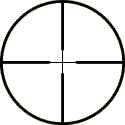 |
|
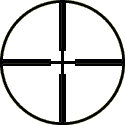 |
|
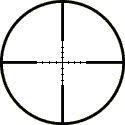 |
| Standard
Crosshair |
Duplex
Crosshair |
Heavy
Duplex |
MilDot |
| Gives precision
aim point but is hard to see in dim light or to pick up quickly |
Gives precision
aim point and aim point can be seen in dim light. Faster aim point pick up then standard. |
Aim point is not
as precise for target use but extremely fast to use under field conditions. |
Used
for ranging purposes and growing in popularity |
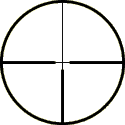 |
|
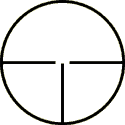 |
|
 |
| German #4 |
German #1 |
Post & Duplex |
| A European reticle
that provides fast acquisition with a fine aim point |
A European reticle
that provides fast acquisition. Popular in the military. |
Similar to the German #4
but offering a more open view |
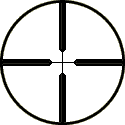 |
| Fr. Frog #1 |
| This would give very fast
pickup under all conditions yet provide for a precise aim point when needed. This design
would probably require an etched glass reticle as current wire technology may not permit
this design. A "post & duplex" version would also be acceptable. Asked to
provide dimensions I'd say a thick section of about 3 or 4 moa and a thin section of .7 moa.
For the spacing between the ends of the thick sections between 18 and 24 moa tip to tip would
probably be
good. |
Leupold & Stevens has a wide variety of reticles that they will install in their
scope for a charge of about $47 and Premiere Reticles has an even larger selection for
Leupold scopes. Leupold's web site is at: http://www.leupold.com
and Premiere Reticles web site is at http://www.premierreticles.com.
Q. What are some good general tests of
someone's shooting skills?
A. There are a lot of folks out there who claim
to be incredible shots. So how can you find out the truth? First, we need to establish
that in the context of my web site we are talking about the practical
use of firearm and not gun games. Second, it's not what someone did once, but
what they can consistently do on demand time after time that counts. With
these things in mind there are several fairly easy to set up tests that will show whether
or not the claimer is as good as they claim to be.
Anyone who does consistently well at any of them is probably a pretty good shot with
their firearm. And remember, it's not what you did once but rather what you can do on
demand that counts. Click here for information on these courses
of fire.
Q. At what range should I zero my (supply your
own caliber) rifle?
A. Most folks zero their rifles at too close a
range. While most shots in the field are taken at fairly short range, zeroing too closely
limits (or at least makes more difficult) hitting targets of opportunity at longer ranges.
Ideally you want to zero your rifle at the longest range that the bullets path does not rise above half of
your target's vital zone. That way you can hold dead on out to a much longer distance than
if you simply zero for say, 100 yards.
If we assume, as many people do, a vital zone size of 6 inches, we want a zero such
that the bullet's path does not rise more than 3" above the line of sight. A good
general rule of thumb is to zero cartridges with a velocity of 2100 to 2300 f/s at about
180 yards, those with a velocity of 2400 - 2900 f/s at 225 yards, and those with a
velocity of 3000 f/s and over at 250 yards.
To obtain an good approximation of these zeros, adjust your point of impact to be
between 2.75 and 3 inches high at 100 yards (the lower figure for the lower velocities and
the higher figure for the higher velocities) and you will be in the ball park. With the
proper zero you will be able to hold dead center for ranges from up close to about 40
yards past your zero range (where the bullet drops more than 3 inches). You should, of
course, confirm things by actually firing at different ranges. (By the way, the .22 rim
fire because of its smaller normal targets is probably best set for about an 80 yard zero
which puts the bullet ¾ inches high at 25 yards, 1.5 inches high at 50 yards, and about
2.5 low at 100 yards.) Of course it goes without saying that you should verify you zero at
the actual ranges.
If you have ballistics software you can refine these calculations for your particular
load.
If you are interested in a more in depth discussion of zeroing visit the
"Zeroing" link on my
"ballistics" pages by clicking here.
Q. How do changing various components
affect chamber pressure and velocity?
A. Changing components can definitely affect
things as the tables below show for the .308 Winchester cartridge. As you can see from the
data, a change of almost 8,000 cup or more is possible simply by changing one component.
If multiple changes occurred the effect could be even greater, and if the initial load was
at or near maximum one could easily get into dangerous territory. This is especially true
of small capacity cases in high intensity rounds like the 9 x 19 mm where case capacity
can vary greatly. Note: These results were typical under the conditions tested. Your
firearm and ammunition may behave differently so don't use this as loading data.
| Changing Bullet
Brands |
Bullet Wt
(gr) |
Bullet Type |
Case |
Primer |
Powder |
Charge
(gr) |
Vel
(f/s) |
Pressure
(cup) |
| 168 |
Sierra |
LC |
W120 |
IMR-4895 |
40.5 gr |
2626 |
52.2k |
| " |
Speer |
" |
" |
" |
" |
2625 |
51.2k |
| " |
Hornady |
" |
" |
" |
" |
2625 |
51.2k |
| " |
Nosler |
" |
" |
" |
" |
2624 |
52.1k |
| Changing Primer
Brands |
Bullet Wt
(gr) |
Bullet Type |
Case |
Primer |
Powder |
Charge
(gr) |
Vel
(f/s) |
Pressure
(cup) |
| 168 |
Sierra |
LC |
W120 |
IMR-4895 |
40.5 |
2626 |
52.2k |
| " |
" |
" |
F210M |
" |
" |
2622 |
51.0k |
| " |
" |
" |
R9½ |
" |
" |
2571 |
45.5k |
| " |
" |
" |
CCI200 |
" |
" |
2581 |
45.5k |
| " |
" |
" |
CCI250 |
" |
" |
2579 |
46.1k |
| Changing Cases |
Bullet Wt
(gr) |
Bullet Type |
Case |
Primer |
Powder |
Charge
(gr) |
Vel
(f/s) |
Pressure
(cup) |
| 168 |
Sierra |
LC |
W120 |
IMR-4895 |
40.5 |
2626 |
52.2k |
| " |
" |
FC |
" |
" |
" |
2586 |
44.7k |
| " |
" |
WW |
" |
" |
" |
2580 |
45.3k |
| " |
" |
RP |
" |
" |
" |
2589 |
46.4k |
Data courtesy NRA.
Most reloaders standardize on a particular brand primer and bullet for a given load and
the factor most likely to change is the cartridge case since most shooters will pick up
anything that looks like brass. To give you an idea of how things can vary look at the
difference in case weights for representative cartridge cases that I have
measured. The weights are based upon the average of 10 fired,
cleaned, and unprimed
(but otherwise unmodified) cases. Your cases may differ with different
lots so don't count on these figures.
(If you can supply data on other cases I'd greatly appreciate it
| 9 mm Case Comparison |
| Brand |
Case Wt.
(gr) |
| Jegemann |
54.2 |
| S&W |
54.8 |
| Super Vel |
55.1 |
| Speer |
55.2 |
| WW |
55.3 |
| Starline |
57.3 |
| Remington |
58.1 |
| Browning |
58.9 |
| Hornady |
60.0 |
| Norma |
62.0 |
| Federal |
63.0 |
| Aguila |
63.0 |
Israeli Military
(TZ) |
66.2 |
US Specification for the
9 x 19 NATO cases is
"nominally 57 gr" |
|
|
.40 S&W
Case Comparison |
| Brand |
Case Wt.
(gr) |
| Federal Nickel |
63.4 |
| Federal |
63.6 |
| WW |
64.8 |
| Remington Nickel |
66.8 |
| GFL |
66.9 |
| Speer Nickel |
67.1 |
| CCI |
68.3 |
| |
|
| |
|
| |
|
|
| .308 Case Comparison |
| Brand |
Case Wt.
(gr) |
| Federal (old) |
158.2 |
| WW (Old) |
159.9 |
| Hirtenberger '84 |
161.3* |
| Norma |
165.6 |
| Remington |
170.5 |
| Lapua |
171.8 |
| Sako |
172.0 |
| Lapua(recent) |
173.2 |
| Federal (Current) |
175.4 |
| Federal Nickel (Current) |
177.1 |
| WCC 67 |
177.4 |
| LC 76 |
179.0 |
| Samson Match |
179.2 |
| WW (Current) |
179.2 |
| LC 77 |
179.3 |
| LC 79 MATCH |
179.4 |
| LC 67 MATCH |
179.5 |
| LC 74 |
179.9 |
| IMI 308 Win |
181.0 |
| FA 65 |
182.7 |
| FNM '82 |
194.1 |
| * These
case have a much smaller than normal flash hole
US Specification for the
7.62 x 51 NATO case is
190 +0, -20 gr
|
|
| 5.56
mm Case Comparison |
| Brand |
Case Wt.
(gr) |
| Federal |
88.6 |
| PMC |
91.3 |
| ZV 9 9 NATO |
91.4 |
| L C 9 2 NATO |
91.7 |
| L C 8 9 NATO |
92.5 |
| T W 6 8 |
92.5 |
| W C C 8 5 |
92.7 |
| WW Nickel |
92.8 |
| WW |
92.9 |
| IMI |
93.0 |
| WCC87 |
93.2 |
| Hornady |
no data |
| Norma |
no data |
| Remington |
no data |
| |
|
| |
|
| |
|
US Specification for the
5.56 mm cases are 94 -5 gr for M193 cases and 95 -6 gr
for M855 NATO cases |
|
|
.45 ACP Case
Comparison |
| Brand |
Case
Wt
(gr) |
| Federal |
84.2 |
| Winchester |
87.5 |
| R-P |
85.6 |
| IMT |
87.1 |
| WCC 67 |
|
US Specification for the
.45 ACP cases is "nominally 87 gr " |
|
.30
Carbine
Case Comparison |
| Brand |
Case Wt.
(gr) |
| WW |
71.6 |
| RP |
68.7 |
| RP-UMC |
71.4 |
| CBC |
73.0 |
| Federal |
69.9 |
| LC |
69.9 |
| S&B |
71.9 |
| WRA |
69.4 |
| WCCl |
69.5 |
| Aguila |
69.5 |
| |
|
| |
|
US Specification for the
.30 Carbine cases is 71 -6 gr |
|
In the 9 mm cases the difference in case weights translate to tremendous difference in
case capacity. There is an old rule of thumb that for equivalent pressure, charge weight
varies by about 12 percent of the difference in case weight. While this rule of
thumb is based upon .308/.30-06 size cases it hold true fairly closely for
other case sizes and can at least keep you out of major trouble.
For example, a load developed in 9 mm Winchester brass listed above would have to be reduced by about 1 gr in Remington cases
and a whopping 1.3 gr to maintain the same pressure in TZ cases. In a cartridge like the 9
mm where typical powder charges run 5 to 6 grains that's a big 22 percent change.
In the
.308 examples above the change incurred from the lightest to heaviest cases would be about
4 grains. With a typical 45 grain charge weight that's about an 8 percent change. It should
be noted that average case weight can vary from lot to lot (usually no more than about 2
gr) within a particular brand of rifle cases. With .308 size cases
differences in average weights of about 1.5 gr can probably be ignored
safely. In 5.56 the charge difference can be around .6 gr which with
an average charge of powder (27 gr) would about a 2 percent change. The .40
S&W has similar issues.
You should also be aware of the fact that the burning rate of your powder can change
slightly from lot to lot. Although the lot to lot consistency these days is quite
remarkable there is still the chance that things can change. (This is one reason why
big-time match shooters buy large quantities of a single lot of powder).
No wonder the reloading manuals caution you to drop at least 10 percent from any
maximum charge data and slowly work up. A good rule of thumb for the amount of
an increment to use when working up from a starting load is to fill the case to
the base of the neck with the powder you are using, dump and weight the powder, and to then
use 1 percent of that weight as an increment. As an example, if your case would
hold 55 grains of the powder you are using a good "increment" would be
.5 (5/10) of a grain. Once you get "in the ball park" for accuracy (see
the article on load development) you could then cut that increment to about half (say to .2 gr in this case) to fine
tune things.
Remember. Play it safe. If you change anything drop your load 10 percent and slowly
work back up.
A special warning! Seating
depth, especially in small capacity high pressure cases, like the 9 mm and .40 S&W, has a
major effect on pressure. Tests have shown a 20 - 25 percent change in pressures
with as little as .05" in seating depth in these cartridges. A chart
for the .40 S&W changing seating depth with the same charge and brand of
cases is shown below. If you couple a change from a thin case to a thicker
case with less volume and a change in seating depth it become clear that you can
get in big trouble very fast. This is especially true if you are using
cases that have been reloaded a lot and a pistol that has poor case head
support.
Change in
seating depth
(inches) |
Pressure
(psi) |
| 0 |
35,000 |
| -.05 |
41,500 |
| -.1 |
48,900 |
|
SAAMI specification for
the .40 S&W are
Max Average
Pressure - 35,000 psi
Maximum Probable Lot Mean - 36,100 psi
Maximum Sample Mean - 37,800 psi
Minimum Proof - 45,
5000 psi
Maximum Proof - 49,000 psi |
Pressure changes interpolated from data supplied
by Ramshot Powders.
Q. Are the 7.62 x 51 mm NATO rounds and the .308 Winchester
really the same round?
A. Well, er, ah, umm--kinda. The cartridge cases
themselves are effectively identical with the exception that the NATO specification
rounds (those marked with the NATO "cross in circle" mark) have substantially
thicker cases than the commercial variety and slightly different tolerances on
some dimensions . They are thus able to withstand stretching better when fired in loose
chambered military weapons (done for reliability purposes). There is
a pressure specification difference though.
| Cartridge |
Max Avg
(KPSI piezo) |
Nominal Proof
(KPSI piezo) |
Port Pressure
(KPsi piezo) |
| SAAMI |
62.0 |
83.0 - 89.0 |
n/a |
| NATO |
50.0 |
64.5 - 69.5 |
12.5 +/- 2 |
Thus commercial ammunition may over stress military firearms and their gas
systems and coupled with
the thinner commercial brass and the larger GI chamber may result in case
rupture.
The NATO specs for the cartridge case dimensions reference different datum points for
some measurements but these can be interpolated. Base diameter specifications
.2" from the base of the rim are approximately .4706" - .006" for
NATO specifications and .4703" -.008" for SAAMI. The
specifications for the diameter at the shoulder of the case is difficult to
compute as it is at the intersection of two datum lines but would probably be
slightly larger (.4543" -.006 by my interpolation) than the SAAMI specification of
.4540" +/- 0 at 1.450" from the base of the case. SAAMI gives the case
to shoulder length from the base to
the .400" datum on the shoulder as 1.627" - 1.634" while the NATO
spec is 1.628" - 1.634". However, I have gauged many military
rounds as being well under the minimum specification, especially non-US military
surplus. (After all it was surplused for a reason.)
The GI .7.62 mm chamber has a larger diameter neck (.3445" +.020 vs.
.3442" +.020 SAAMI), a different shaped and dimensioned bullet seat and
throat, and more generous diameter tolerances,
(.4730 + .002 (interpolated at the .200 reference line) compared to .4714 + .002
for SAAMI. I
am working on obtaining drawings for both the cartridges and the chambers and will post them when
available which will show the differences more clearly.
The headspacing requirements for the NATO chamber is much more generous than that of
the SAAMI commercial (.308 Winchester) specifications as can be seen in the table below.
(All dimensions are from the breech face to the .400" datum point at the
shoulder and are taken from SAAMI or US government specification sheets.)
| Gauge |
.308 Win |
7.62 MM NATO * |
7.62 MATCH * |
| GO (Minimum Chamber) |
1.630 +.002 |
1.6355 +.0005 |
1.6355
+.002 |
| NO-GO (Max Chamber) |
1.634 |
1.6405 +.0005 |
1.6385 |
| Field (Reject) |
1.638 |
1.6455 |
|
| * Using
"component" bolt |
Additional problems can arise when commercial .308 ammunition is fired in military specification
chambers since the minimum military chamber is .0015" longer than the SAAMI
maximum chamber. Since commercial ammunition is generally dimensioned to fit in a minimum
sized SAAMI chamber, the thinner commercial brass can be stretched to the failure point when
fired in maximum sized military chambers, while minimum spec military brass is
thick enough to stand the stretching.. In addition, military chambers may also be cut
on the "generous" size diameter-wise to allow for functioning with dirty
chambers. In the other direction, some military ammo may fail to chamber properly in very tight
commercial chambers, although it appears that military ammunition is generally
on the minimum side of specifications.
While reports of catastrophic failures seem to be almost unheard of, it is prudent to keep in mind
that there IS a difference and to use commercial .308 ammunition only in firearms marked
as .308 Winchester. Military ammunition that fits SAAMI chambers properly is
considered safe to use in non-military arms. The headspacing "problem" with military chambers can be
taken care of for a particular rifle and reloads by careful adjustment of your sizing die. Most "commercial" rechamberings are done with SAAMI spec chambers. If in doubt
or really paranoid do a chamber cast.
... and the .30-06. For all intents and purposes the cartridges
and chambers are the same. However, US military ammunition is loaded to a
specification of 50 - 54 Kpsi average (depending on the particular type of
round) while the current commercial .30-06 ammunition is loaded to 62 Kpsi
average. In bolt action rifles this isn't a major thing but in the M1
Garand use of commercial ammunition can lead to battering and the bending of the
operating rod.
Q. Are the 5.56 mm NATO rounds (and
M193 types) and the .223 Remington really the same round?
A. This is another of those "Well, er, ah,
umm--kinda" items.
There is a slight difference between .223 Remington and 5.56 x 45 mm military
ammunition. While the cartridge cases themselves are identical
(although some dimensions are referenced to different datum points), with
the exception that military and/or NATO specification rounds (those marked with the NATO
"cross in circle" mark) may have thicker cases and are thus able to withstand
stretching better when fired in loose chambered military weapons (done for reliability
purposes). From the data I have seen the headspace
specifications are identical for SAAMI and military ammunition although,
again, measured
to different datum points and the dimensions of the cartridge cases are the
same. While the standard .223 and 5.56 NATO use
the same headspace gauges, the Colt factory uses a special "maximum field
gauge" that is much longer than the normal field gage to reject rifles.
| Gauge |
.223 & 5.56 NATO |
| GO (Minimum Chamber) |
1.4636 |
| NO-GO (Max Chamber) |
1.4666 |
| Field (Reject) |
1.4696 |
| Colt Factory GI Reject |
1.4736 |
The chamber dimensions are where big differences are. While there are
just minor dimensional and tolerance differences in the body area, the big
differences are in the throat areas.
There are actually 3 standard chambers, SAAMI, US GI NATO, and FN NATO.
Commercial SAAMI specification .223 chambers have a much shorter throat, a smaller
diameter bullet seat, and less freebore than the US GI military
chamber and the NATO chambers. This
typically results in the ogive of the M193 Ball bullet touching the ball seat of
the SAAMI chamber. The profile of the M855 bullet is similar and it is also
loaded hotter than M193.. When military
specification ammunition is fired in a SAAMI specification chamber chamber pressure can
increase dramatically--M193 typically goes up 3 - 5K psi (from a nominal 55K,
while M855 goes up about 10K from a nominal 58K). While this should not cause any
problems in modern well made rifles it should give one pause. Conversely, SAAMI
specification commercial ammunition when fired in a military chamber gives significantly
lower pressures and velocities.
The reason the big difference in
the NATO chamber is that the deeper intrusion of the M856 tracer bullet into the
powder space was found under some conditions to cause riveting of the bullet,
which gave a steep pressure spike. (This has also been seen with 77 gr and 80 gr
match bullets.) Thus the FN NATO 5.56mm chamber has an intermediate
11 degree, 30 minute cone transitioning between the case shoulder and the case
neck to help eliminate this problem. as marked with the red dot on the drawing
below. This chamber is primarily used on the M249 SAW. The US
"NATO" chamber used in the
M16 rifles does not have this double shoulder but otherwise they are identical.
The data below shows the dimensional differences between the US
GI NATO and SAAMI chambers.

| Legend |
Item |
.223
SAAMI |
5.56
mm |
Difference |
| C |
Base Diameter |
.3803 |
.3803 |
0 |
| D |
Shoulder Diameter |
.3553 |
.3553 |
0 |
| E |
Neck |
.2550 |
.2551 |
.0001 |
| F |
Neck (Case mouth) |
.2540 |
.2540 |
.0 |
| G |
Freebore Diameter |
.2240 |
.2265 |
.0025 |
| K |
Base to Case Mouth |
1.7720 |
1.7750 |
.0030 |
| L |
Base to Shoulder |
1.4338 |
1.4338 |
0 |
| M |
Neck Length |
.2201 |
.2202 |
.0001 |
| N |
Freebore (Lead)
Length |
.0250 |
.0566 |
.0316 |
| O |
Datum Point From
Breach face |
.2000 |
.2000 |
0 |
| Q |
Shoulder Angle
(Deg) |
23 |
23 |
0 |
| R |
Throat Angle (Deg) |
3.10.36 |
1.13.25 |
-
1.57.06 |
| Z |
Throat Length |
.0811 |
.2693 |
.1182 |
|
Dimensions in inches.
SAAMI length tolerance = +.0050. NATO length tolerance =
+.0040. Diameter tolerance for both is +.0005 Angle tolerance
is SAAMI +/- 2 min, NATO is +/- 15 min
FN NATO CHAMBER - The above drawing does not
show the double shoulder angle (a the red dot) of the NATO chamber. The deeper intrusion of the M856 tracer bullet into the
powder space was found under some conditions to cause riveting of the bullet,
which gave a steep pressure spike. The FN NATO 5.56mm chamber has an intermediate
11 degree, 30 minute cone transitioning between the case shoulder and the case
neck (at the area marked by the red dot) to help eliminate this problem. The shallower NATO throat angle
gives a longer throat to the same dimension datum (.215 )than the SAAMI
spec. See drawing below for detail of the dual angle NATO chamber.
SAAMI data from SAAMI drawings
in ANSI/SAAMI Z299.4-1992.
US NATO data from print 8448549/8448550
|
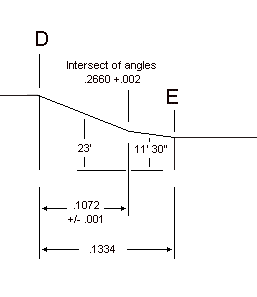 |
|
*NATO dual angle detail |
It must also be noted that all 5.56 x 45 mm NATO ammunition (such as US
M855) requires a 1:9" twist or faster rifling to stabilize the long 62 gr ball bullet
and a 1:7" twist to stabilize the extremely long tracer variation. The standard
twist used for .223 Remington commercial chamberings is 1:12" or 1:14" neither
of which will stabilize the NATO type ammunition. There does seem to be a
recent push to standardize the 1:9 twist for .223 though. The NATO ball ammunition is easily
identified by its green bullet tip.
The piezo pressure specifications for SAAMI, M193, M855, and CIP (European
standards) ammunition are given
below. Keep in mind that the SAAMI pressures are taken in a SAAMI spec
test barrel and measured 32 mm from the base of the case. Military pressures are taken in a mil-spec
barrel and chamber and are measured at the case mouth. CIP pressures are
measured in a CIP standard chamber and are taken 25 mm from the case base.
| Standard |
Max Avg
(KPSI piezo) |
Individual Max
(KPSI piezo) |
Nominal Proof
(KPSI piezo) |
| SAAMI |
55.0 |
56.4 |
71.5 - 77 |
| M193 |
55.0 |
61.0 |
70.0 +/- 3.5K |
| M855/NATO |
58.7 |
64.7 |
70.0 +/- 3.5K |
| CIP |
62.3 |
67.8 |
72.4 - 77.9 |
Q. What was the largest gun in history?
A. The largest gun ever used in combat
is generally accepted to be
the German "Gustav Gun" (and its sister canon "Dora") built in 1941 by the Krupp company. It had an 80 cm bore
(31.5") and fired either a 10,500 lb HE projectile (which made a crater 30 feet wide
and 30 feet deep) or a 16,500 lb concrete piercing projectile (which would penetrate 264
feet(!) of reinforced concrete). The typical powder charge was about 3000 lb of powder.
The range was between 23 and 29 miles and the muzzle velocity was about 2700 f/s. The gun
weighed 1344 tons and had a crew of 500 men. It was used by the German's during the siege at
Sevestapol in April 1942.
![The Gustav Gun [36k jpg]](gustav.jpg)
One round from Gustav destroyed a Russian ammunition dump 100 feet below Severnaya
Bay and covered by 10 meters of concrete, and a near miss capsized a large ship in the harbor.
Gustav fired 300 rounds during the siege wearing out the original barrel in the process.
A second gun, called "Dora" was set up west of Stalingrad in mid-August.
It was hurriedly withdrawn in September to avoid capture and never saw action. Gustav next appeared outside Warsaw, Poland,
where it fired 30 rounds into Warsaw Ghetto during the 1944 uprising.
Late in WW II the US developed a "mortar" called the Little
David which fired a 36 inch (92.5 cm), 3700 pound shell containing about 3/4
ton of explosives about 10,000 yards. Intended for use during the invasion of
the Japanese homeland, it was never fired in combat. It required 2 tractors to
transport the base and the tube separately.
 |
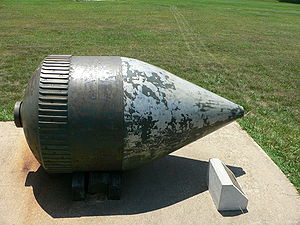 |
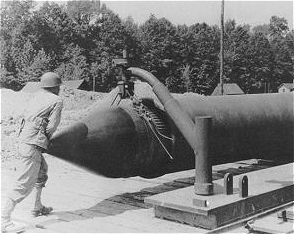 |
| Mortar in place |
36"
projectile |
Loading
projectile |
Q. Can you recommend any "homemade" gun cleaning or lubricating solutions?
A. Due to the amount of information
this section has been moved to its own page. Click
here to visit it.
Please email comments to Fr. Frog by clicking
here.
| Back to Q&A Index | Ballistics Main
Page |
| Back to Fr. Frog's Home Page |
Disclaimer
As far as I know all the information presented above is
correct and I have attempted to ensure that it is. However, I am not responsible for any
errors, omissions, or damages resulting from the use or misuse of this information, nor
for your doing something stupid with it. (Don't you hate these disclaimers? So do I, but
there are people out there who refuse to be responsible for their own actions and who will
sue anybody to make a buck.)

Updated 2020-02-29










![The Gustav Gun [36k jpg]](gustav.jpg)


